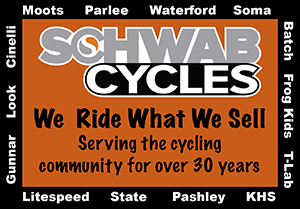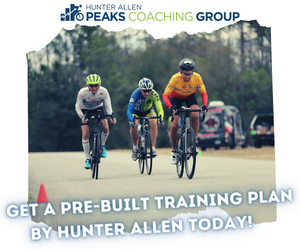

1986 Coors Clasic
By Owen Mulholland
Back to Rider Histories index page | Men's Race | Women's Race | Race Notes |
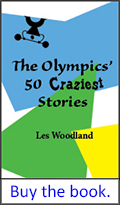
Les Woodland's book The Olympics' 50 Craziest Stories: A Five Ring Circus is available as an audiobook here. For the print and Kindle eBook versions, just click on the Amazon link on the right.
After following the 1986 Tour de France and reporting the contentious drama of Greg LeMond's attempt to win while his teammate Bernard Hinault constantly undermined him, Owen Mulholland followed the 1986 Coors Classic. There, it turned out that without pause LeMond and Hinault had continued their rivalry. Owen also followed the Women's Coors and found just as much friction between the French champion and the Americans.
As perhaps befits a nation caught in a state of perpetual self-examination, the Coors Classic, America's premier bike race, is ever in revision. This search for identity may or may not be a crises.
On the positive side is a comparison with, say, particle accelerators. Moscow's is massive, powerful and crude; Geneva's is constructed with typical Swiss meticulousness; and Chicago's Fermi is never quite complete. If the Coors is like Fermi then the endless tinkering can be viewed as a natural restlessness and perpetual search for something better.
Less optimistic is the fear that the Coors is desperately groping for a formula which will make it a desired entity in itself. The Coors grew up with the bike boom of the seventies. To ride a good Coors (or Red Zinger as it was called then) just about made an American bikie's career. Problems arose in 1984 when our best amateurs used the Coors as a preparation race for the Olympics. This year, 1986, was analogous. Home and foreign riders viewed the Coors as a stepping stone to the succeeding World Championships in Colorado Springs.
By positioning his race just before a bigger event, director Michael Aisner has been able to draw together some very classy fields. However, several of the name riders have not ridden with much inspiration, making their inclusion a dubious matter. More threatening is what happens when the "bigger event" disappears. Olympics and Worlds are not frequently on the domestic cycling menu, the former having a gap of 52 years and the latter 74 years!
Obviously, Aisner wants to create a race which will bring the hottest honchos from around the world. Competitors must be attracted to the Coors by its own virtues, and not those of the next event.
This year support for Aisner's pioneering efforts came from the best source possible, Bernard Hinault. That five-time winner of the Tour de France would choose the Coors as his career ending stage race victory gave status to the race which no hype could have ever achieved.
From the first pedal stroke in the San Francisco prologue time trial, Americans got to see the "Badger" of renown. Last year he cruised through the race on autopilot, content to support Greg LeMond and only show his real self on rare occasions. This year, as anyone who followed the Tour de France knew, Hinault was in the best form he's enjoyed for years. As he said on several occasions, "When I have form like this, I don't have the right not to try to win."
But this was no demo run. Hinault's victory meant something because it came at the expense of some very worthy opposition.
As usual, number one on that list was 7-Eleven. The familiarity of such names as Ron Kiefel, Eric Heiden, Davis Phinney, and Doug Shapiro is based in large part on their annual memorable performances in this most prestigious of domestic races.
Ron Kiefel claimed he was tired from the Tour de France, but it's hard to imagine how he could have won much more convincingly on the 18 percent slopes of San Francisco's Telegraph Hill in the prologue time trial. Nearly six seconds separated him from second place, Piotr Ugrumov of the Soviet Union. Six seconds in an even that lasted just over three minutes is enough to make one doubt the timing system. Just consider…six seconds covered the finishers in second through eleventh places!
The fact that this was Ron's fourth consecutive prologue win wasn't lost on the knowledgeable San Francisco crowd. Estimates ranged up to 40,000 in attendance. Whatever the numbers, the upper limit seemed to be sidewalk space rather than attempts to attend. Every side street was clogged with craning necks while those lucky enough to be on the rope barricades pushed into the streets creating a human canyon up which the pounding riders got the best "treatment" this side of Italy. Between the fans with programs and the race marshals with their bullhorns, the crowds were "prepped" for each rider. Politics and modest reputations evaporated. The sporting ribbon up the hill responded vociferously to every racer. It seemed hardly possible, but an extra decibel was kept in store for the likes of Hinault, Phinney, LeMond and Kiefel.
The name "Telegraph Hill" harkens back to the clipper ship days when a lookout using a spyglass could identify a ship entering the bay and then "telegraph" (using semaphores) that information to the docks below. On this day, the telegraph was very much in use, only the direction was opposite and the medium was sound. Despite the anemic coverage by the local media which concentrated almost exclusively on the Gay Olympics being run in another part of town, this was the happening event in San Francisco. Name your criteria: attendance; money; international prestige…the Coors had it all.
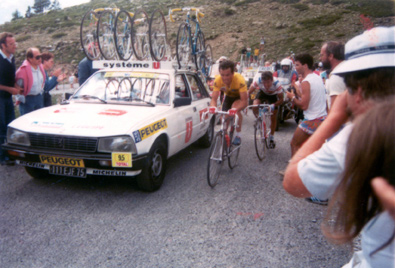
Bernard Hinault in the 1986 Tour de France
The buildings seemed to sway to Bernard's rocking big gear style and the rhythmic chants of "E-no! E-no!" It's hard to understand after all the problems with the local hero, LeMond, but American fans obviously respect and admire the Frenchman for his career record and attacking style; petty rivalries can't be allowed to intrude on serious hero worship.
"Bernie," as Aisner likes to call him, improved 40 places on his '85 prologue ride, but it was still a ways from a winning time. Although absolute times were impossible to take along the course, relative splits gave a sense of the standings. When the time of 7-Eleven's super hot Mexican discovery, Raul Alcala, stood up to the onslaughts of such legends as Steve Bauer, Andy Hampsten, Davis Phinney and Moreno Argentin, the crowd knew this was the standard to measure the few remaining rides. Piotr Ugrumov (USSR) was obviously onto a good one, but attention was focused most closely on Ron Kiefel and Greg LeMond, the last two starters. The watch confirmed appearances when the 26 year old Kiefel lunged past. This man was in another dimension!
When another minute went by and Greg wasn't in sight everyone knew Ron must be the winner. What people didn't know, except for those standing where it happened, was that Greg's chain had derailed on the steepest section and he'd had to get off and restart.
The excitement continued unabated into day two where an expanded Fisherman's Wharf circuit showed off one of the things the Coors does best, super hot criterium racing. Riders started dribbling off the back almost immediately when the intense pace just wouldn't let up. Alan McCormack, the 29 year old leader of the Killians' Irish Red Team, capped a scintillating 1 1/2 hours with a death dive move in the final corner. He emerged reincarnated as the winner.
The show moved on, but San Francisco, perhaps America's most European-style city, still reverberates to those two days of bike racing, August 9th and 10th. Old time fans still speak in hushed tones of seeing those so-famous pros on their familiar streets. It still doesn't seem true. But anyone who heard those chants of "E-no! E-no!" can be assured it was the real thing. Michael Aisner and his staff have done the heretofore virtually impossible, planted the Coors in the center of a major city and seen it grow as though the urban landscape were virgin topsoil for racing.
Exciting as the first two days were, those close to the race knew it was just fluff. The next three days to Reno, three long, classic mountainous point-to-point races would be the real weights on the scale of overall race leadership.
The mighty Red Zinger team (La Vie Claire for the rest of the year…Hinault, LeMond and company) decided it was time to assert itself. One look at the 102-mile profile from Sonoma to Sacramento showed there was plenty of opportunity to make a first selection. Trinity Mountain Road rears up outside Glen Ellen, the town Jack London made famous. An average gradient of ten percent for two miles guaranteed major gaps.
The road connects the viticultural regions of the Valley of the Moon and Napa Valley, but the insatiable fans had eyes only for their heroes. They didn't have to look very hard. LeMond and Hampsten were right up front putting on the big hurt. Thirteen could stand the pain.
Across Napa Valley and LeMond floored it on the next climb. Four others latched on. Their names were important: Andy Hampsten (Levi's), Bruno Cronillet (Peugeot), Raul Alcala (7-Eleven) and Janus Kuum (Schwinn-Icy Hot). When their lead built to ten minutes at the 60 mile mark and diminished slightly to 7 minutes and 53 seconds in Sacramento, the race appeared to be over for everyone else, which is just what the Zinger boys had intended.
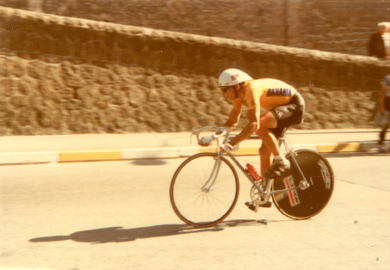
Greg LeMond in the 1986 Tour de France
This was professional racing. With the five strongest teams represented in the break, their teammates back in the bunch locked the vault. Only two teams had the power to chase, Bianchi and the Soviets. There were fewer than ten of them in the leading chase group, against over twenty of the assembled opposition. Every time a Bianchi rider, say, would take a long, hard pull at the front of the chase group, he would see his efforts neutralized by the next man in line. Very discouraging stuff, and the enormous gaps showed it.
Such clinical precision in the peloton was not matched by the organization. Some year Michael Aisner will put on a flawless race, and certainly the '86 edition was a quantum improvement on the snafu-plagued '85 Coors, but as long as he had to rely on volunteers, however enthusiastic, there will always be the risk of the kind of problem Bruno Cornillet encountered practically within sight of the finish line.
While Hampsten and LeMond eyed each other, Bruno got away within the Sacramento city limits. Up the capitol mall he roared before beginning the loop around the capitol building which preceded the finish back on the mall. This entailed six corners. All it took was for one to be unmarked and unmarshaled and the poor Frenchman got an unexpected tour of the capitol neighborhood.
Greg won the group sprint for second and was surprised to learn he was first.
Greg admitted he didn't make the same mistake as Bruno because, "I knew I had to turn left because I rode the course last year, but it was a poorly marked corner." Greg, always honorable, went on to refuse the first place prize. "It's not my race. Give it to Bruno," he insisted, and eventually the judges agreed.
That night's Old Sacramento criterium once again drew huge crowds and also showed that Davis Phinney never goes so well as when wounded. His still healing wrist, wrapped in a brace, took a terrific pounding on the notorious riverside cobbles, but come the sprint he was in his accustomed spot, first. Second was his old nemesis, Steve Bauer, the omnipresent Canadian rival from amateur days.
Two hard stages in one day meant most of the riders were looking forward to a quiet start of the longest stage with the most climbing which came the following morning in Nevada City.
The stage opened with five laps of its notorious criterium course. The 82-man field was content to roll around the severe undulations as best it could. Even going slowly those hill hurt. One man was prepared, however. Phil Anderson, the fiery Australian, had every reason to be aggressive. He'd missed the break the day before and lost almost three minutes due to a flat in the Sacramento criterium That put him 10 minutes 49 seconds down on the race leader, or six from last, well below the expectations he's had for himself in this race.
On the climbs out of town others jumped on board. Again, names to remember: Dag-Otto Lauritzen (Peugeot), Doug Shapiro (7-Eleven), Jeff Pierce (Schwinn-Icy Hot), Theo DeRooy (Holland Pro), and Moreno Argentin and Valerio Piva (Bianchi). The best-placed was Argentin in 20th in General Classification at 8 minutes 27 seconds. The top five on G.C. felt there was nothing to fear.
Once again, though, those behind were paralyzed by tactical considerations. While the break worked in harmony, the field dawdled along playing a gentlemanly game of "after you". Only after the news came through that they were over fourteen minutes down did they get inspired. They pulled back almost six minutes in the last few miles, but it still left a 9 minute 6 second gap, the largest in Coors history.
Lauritzen, the Norwegian on the Peugeot team, became race leader, but his grip was obviously tenuous. Eleven others were within 2 minutes 3 seconds. There would be no more "gift" breakaways. Each team would be calculating how to whittle down this elite group.
The Hinault-LeMond rivalry was obviously back on full boil. Bernard was now in fourth overall, almost a minute ahead of Greg. Mixed signals and shrouded intentions once again made La Vie Claire anything but.
The rest of the Coors became a squeeze play. Anyone who cracked would never get a chance to recover. So while LeMond got a sentimental victory into his hometown of Reno, and Davis Phinney and Ron Kiefel did their usual scintillating criterium show that night, it remained for the "Tour of the Moon" at Grand Junction, Colorado to make the first big changes.
The good news for the organizers and their transfer of the race entourage to Colorado was that Continental Airlines did the flight for free. The bad news was that the riders had to get up at 4 a.m. to catch it. Such disruptions in riders' schedules affect the differently.
This time (last year is was Steve Bauer) it was Doug Shapiro. Starting the second lap Shapiro knew his legs were going. He tried to stay on the front and bluff by setting a good tempo. But he just couldn't match the acceleration for the climbers' prime sprint. The only other 7-Eleven rider in the group, Raul Alcala, dropped back to help Doug.
Like sharks tearing at a wounded brother, the lead pack instantly united to capitalize on 7-Eleven's weakness. By the finish line Shapiro and Alcala were four minutes adrift, very much dismembered from the G.C. picture.
Thanks to the play of time bonuses, Lauritzen had been succeeded as race leader by Shapiro in Reno. That glory passed all too quickly and now Jeff Pierce was in the coveted race leader's jersey. But looming just five seconds behind him, like a king cobra in strike position, was the Badger himself. Forty-eight hours later, the Vail Pass time trial promised to be, indeed, the "race of truth".
In 26 minutes and 56.4 seconds, Hinault demonstrated a truth known to cyclists around the world for nearly a decade, he is the strongest. At the start Greg had real hopes of winning the uphill time trial, which, at over 8,000 feet is a real exercise in oxygen deprivation. But the 31 year old Frenchman is still awesome. Greg did get second, but at 50 seconds! LeMond had no excuses. "He killed me," he admitted. Pierce, down in thirteenth place suffered even more.
With Bernard and Greg one-two it was a rerun of an old story. Both swore they wouldn't hinder each other and both said a win for the team was their primary concern.
The detente lasted just a day until Hinault rolled off the front half-way through the Vail - Copper Mountain stage. In the move too were Pierece, Phinney, Shapiro, Anderson, and a few others with every incentive to go fast. Just as interesting was the list of absentees: Lemond, Hampsten, Alcala, Lauritzen and Kuum.
While Bernard beamed at his job well done, Greg fumed at his own lapse to fourth on G.C.. Paul Koechli, the Red Zinger coach, had even driven up to Hinault and asked him not to pull. Hinault refused and later explained, "Paul and I have different perspectives on the race. But since it's I who pushes the pedals, it's I who will make the decisions." Spoken like a true badger.
Hinault now owned the 1986 Coors Classic. Supported by the strongest team in the race and in super form, he appeared invulnerable. His biggest scare came in the Estes Park circuit race. It's a difficult course with a nasty hill and many turns. A storm blew in, drastically dropping the temperature, and through the sheets of freezing rain Greg attacked with Raul Alcala. Once Phil Anderson got up to them, Greg stopped working as Phil was a direct threat to Hinault.
But Bernard, suspecting treachery, went on the warpath. Then a spoke broke and Bernard was forced to make a wheel change. He stopped at the pits, threw his bike on the ground, and screamed at Koechli for not restraining LeMond. Almost a minute passed before he was back in the saddle.
Assisted by teammates Steve Bauer and Jean-François Bernard, the deficit was slowly eliminated. Also eliminated was Jeff Pierce who couldn't hold onto this express train in the rain. Once together at the front, Moreno Argentin went away in the closing laps to win one of the most dramatic stages in Coors history.
But the drama didn't end at the finish line. Right out in front of God, the public, and everybody, Greg and Bernard exploded in a shower of French epithets. Greg concluded matters by giving Bernard the bent elbow.
LeMond felt the whole incident was one more example of injustice. "Hinault overreacted, " Greg explained. "I didn't do anything wrong. He doesn't talk to me now, and I don't talk to him, in any language. I'll be looking for another team if things don't change."
Later things calmed down. Hinault compared the situation to family life where everyone knows there are good days and bad days. Greg, in turn, said he had been Bernard's friend for six years and hoped to end their racing days on that note. (Bernard promises to retire at the end of the season.)
With peace restored the mighty Red Zinger juggernaut rolled on. LeMond got up to second place overall in the last time trial; Bernard Hinault rode serenely to victory; and Michael Aisner could take satisfaction from having seen his race won by the most famous man in cycling. He could not have wished for a better omen.
Jeannie Longo has become the Marcus Allen of women's cycling. The Raider strategy of Allen to the left, Allen up the middle, Allen to the right, pretty well fits the French Lady's dominance of this year's Coors.
Last year she won five stages on a series of mostly flat and much criticized courses. A more hilly layout this year was suppose to give Longo's opponents more opportunities, but they came up short. (Sorry, couldn't resist.)
At the end of the first day Jeannie had the red race leader's jersey firmly on her back and all but two rivals at a comfortable distance. The biggest loser of the "Tour of the Moon" was Inga Benedict (Inga Thompson until the Monday before the race). After the Tour de France where Inga climbed very well, she was expected to give Longo a serious challenge. Losing a minute and a half on the first stage was a major handicap. For every stage win Jeannie would get an extra 30-second bonus. The only way to beat her was to drop her on the hills or beat her in the time trials, and then by enough margin to make up for those bonuses.
The truth of this was demonstrated on stage two, three, and four. Inga showed her real self in the stage three Vail Pass time trial by taking 50 seconds out of Longo. Jeannie, however, won stages two and four. Net benefit to Longo: ten seconds.
Of course there were more than just the lady with the waist length braid (Benedict) and the French woman in the race, and by stage five they began to show themselves. Both had come to the Coors sick or wounded and it had taken most of the week to adapt.
Opportunity stood out in the profile of the Copper Mountain stage which crossed the 11,316-foot Fremont Pass twice. Mighty Maria Canins, Italian winner of the Coors in 1984, twice winner of the Tour de France, and winner of everything else with big climbs, showed there was plenty of life left in the 37-year old body by taking the prime the first time over the top of Fremont. Maria admitted to having an unusually difficult time adapting to the altitude this year, so she didn't try to capitalize on her slight advantage.
At the turn-around point in Leadville, Katrin Tobin, recently crowned U.S. Women's Road Champion, jumped for the prime and kept on motoring. The former Stanford student would like to do in cycling something akin to what her Stanford compatriot, John McEnroe, has done in tennis.
Her initiative was matched by only one other racer, Madonna Harris, last year's Coors discovery. Madonna, a New Zealander by birth, and formerly a Utah triathlete by choice, took off after Katrin when the gap got to 50 seconds.
Incredibly, no one chased. Clearly, the former third-place finisher in the Coors was a serious threat to all sorts of people. The mostly American field seemed to feel the onus was on Jeannie to chase, and she felt just as strongly they had more to lose.
It's true that Jeannie was rather isolated, being in a thrown-together Red Zinger team with two weak teammates (Neil of Canada and Top of Holland) and Boulderite Leslie Schenck. Leslie could be of help on the flat, but heading back up the pass, the natural strength of the top riders saw them ride away from the field.
Longo, Canins, Benedict, and another emerging face, Susan Ehlers (Centurion team) scarfed up a dropped Tobin near the summit. Katrin gritted her teeth to hang on, and then the former downhill skier had the temerity to attack again.
While Ehlers thought of the sprint and Inga refused to pull really hard, Canins and Longo were left to do the real chasing. They tried to strike a balance between losing too much time and overtiring themselves. The result was that Harris won, Tobin finished at 38 seconds, and Jeannie took the sprint for third (ten-second bonus) at 52 seconds.
Longo was clearly upset by what she considered open collusion between Americans of different teams. All parties agreed on the fact, for example, that Inga had led out Katrin for the Leadville prime. But where Longo took offense, Tobin saw it as a natural outcome of Americans wanting to do well in their own race. "It's nothing personal against Jeannie," Katrin said assuringly. These semantic niceties remained lost on the foreign lady.
As with the men, the Estes Park circuit made for a volatile combative race. You know that 3,000 feet of climbing in 27 miles is bound to shake things up.
The kindling point was reached at the midpoint when Harris crashed and delayed all but Longo. Jeannie didn't wait and Inga set out in lone pursuit. With two laps to go Longo was caught. The crowd roared Inga on and she obliged by going up a gear. Only the strongest can get away with such a bold move. If you crack in a big gear it's like your legs are frozen in cement. But Inga wasn't cracking. She was flying away to a momentous victory that gave her many fans cause to hope that the Grenoblois might be vulnerable yet. In all she pulled back 39 seconds to close within 1 minute 16 seconds.
Their dual continued right on into the press room where Jeannie openly accused Inga of illicit cooperation and Inga just as hotly denied the charge. "I've been to the Tour of Norway and the Tour de France, and I'm sick of the Europeans always winning. I want to see an American win and if an American is off the front I'm not going to chase. There's a difference between working together and not wanting to work. As far as I'm concerned blood is thicker than water. All we get here are cheers. The crowds push the Europeans in the Tour." The shouting match ended with Jeannie walking out.
There was no chance of shady riding two days later when Benedict pulled back 25 seconds in an 8.4-mile time trial. That left Inga only 35 seconds down on G.C., but once again Jeannie worked the bonus game by winning the Denver criterium that night. Inga was back to a 1 minute 5 seconds deficit.
The renowned Morgul - Bismark stage gave Canins and Harris the chance to move up to third and fifth respectively, but between the top two there was a stalemate. Everywhere that Inga went, Jeannie was sure to follow.
The final day's North Boulder Park circuit race promised to do little more than entertain the crowd. But the inclusion of a hill every lap makes this a demanding race. Where most were thinking survival, the dominant U.S. team, Centurion, was thinking possibilities. Just 18 seconds separated their Susan Ehlers from third-place Canins. Just maybe Maria was vulnerable.
In turn the Centurion riders attacked, showing the kind of coordinated aggression little seen in the Coors since Connie Carpenter's retirement. Finally, they sprang Susan with a daunting 15 laps to go. Blown on by the crowd she couldn't even think "hurt".
When her lead climbed to over a minute Inga became vulnerable. Susan needed 1 minute 9 seconds plus the 30-second bonus to do it. At three laps to go the margin was 1 minute 4 seconds. Inga, having a bad day, and relatively unsupported by her even weaker teammates, was helpless.
At the finish line Ehlers had 1 minute 17 seconds on Benedict and a courageously won second place overall. On the last lap Longo powered away from the pack to solo in, demonstrating that she was indeed the strongest, no matter how the math made things look.
Jeannie smiled for the first time in a week. On the podium with Bernard Hinault she purred, "an all-French win. I think it is beautiful."
Jean-Michel Forest, L'Équipe's reporter at the Coors (L'Équipe is France's biggest sporting paper and sponsor of the Tour de France) was frequently frustrated at the Coors. Due to the time difference between the U.S. and France he was under a lot of pressure to get results as soon as possible. The up to three hour delay in obtaining results was a source of constant annoyance. On the final day he made his own calculations and then discovered the press room with its telephones was clear across town. Undaunted, he knocked on the door of a nearby resident's home and begged permission to use the phone. Permission granted. Mission accomplished.
After the Sacramento criterium, someone invaded the Red Zinger van and stole Christian Jordan's bike. Some local kids observed the crime and noted the escape car had a custom license plate reading "Bad Rat". The police claimed there was nothing they could do (!) so the kids tracked down "Bad Rat" and got the bike. They then drove to Squaw Valley to return it and were rewarded by a dinner with Greg LeMond.
The Coors is getting its own version of the Bermuda Triangle. At least the French think so. Last year the French amateur team van broke down near the Utah-Colorado border en route from Reno to Grand Junction. Somehow the oil drained out, the warning light didn't come on (or so the driver said) and the engine fried. This year the French pro van didn't get near so far. Just outside of Reno the van got a flat. There was no spare tire and the van had to be towed. A day and a night is all the time allotted for the 800-mile drive, so delays can be critical. Continental Airlines offered to reroute its Reno-Denver flight just to drop the bikes off in Grand Junction, but translator Justin Palotta couldn't rouse the mechanic. It must have been a good snooze because the bikes were delivered in time by the van, a feat which required 16 hours of nonstop driving.
The post office of Grand Junction issued a special one day only "Tour of the Moon" hand cancellation depicting a bike rider on wheels saying "Tour of the Moon Station" and "Grand Junction, Colorado". The philatelist society of Grand Junction was responsible to arranging this unique tribute to the Coors Classic. A date to remember, August 15, 1986. The Tour of the Moon also marked the 100th stage since this race began back in 1975 as the Red Zinger.
Amazing Davis Phinney is still trying to crawl out form under the shadow of his wife, Connie Carpenter. She has record of 18 stage wins and 27 top three finishes. Entering the '86 Coors, Davis' tallies were 13 golds and 23 top three placings. Two and a half weeks later he had 16 golds and 28 top three placings. One down, one to go.
Crashes are an unfortunate part of bike racing. This year's Coors had its share. Alan McCormack, the fiery sprinter from Dublin and leader of the Kilian's Red team tried to repeat his winning move of San Francisco the next day in the Old Town Sacramento criterium. This time there really was no room to squeeze through in the last turn. He caught a pedal in the fencing, did a spectacular flip, and fractured his arm in two places. He was on the start line the next morning and each of the first three times he was dropped, he battled back to the field. The fourth time he finally had to give up.
Lech Piasecki, last year's Amateur World Road Champion from Poland, touched a wheel and crashed awkwardly on the Nevada City to Squaw Valley stage. He suffered a deep gash in his left elbow, so deep it punctured an artery. After medical attention, he climbed off the stretcher and finished the stage, dripping blood the whole way. He was understandably last, 42 minutes 15 seconds down on the winner. That he finished at all was a miracle. His blood pressure was 70/0, or so it was reported.
Eric Heiden has had a tough summer. After bending a French guard rail with his head in the Tour, he crashed twice in the Coors. The first time was in the stage to Squaw Valley. His biggest indignity was to be fined for drafting when a judge spotted him using a race vehicle to help him chase. He lost only a modest 9 minutes 6 seconds. Three days later he had a more serious tumble, catching a pedal on a turn and going over the bars. Even Mr. Bionic has his limits. He soldiered on for two days but finally had to quit in Vail.
No one is safe. "Winning" editor John Wilcockson, and Coors race director Michael Aisner, decided to sprint from the parking lot to the view point on the summit of 12,095 foot Independence Pass. Coming over the abrupt rise, they encountered a tourist. Both took evasive action, but John slipped on the gravel and went flying, suffering numerous abrasions around his body. John shrugged off the injuries. He is well-known for his ability to identify with the racers about whom he writes and this was the next logical step!
The Löwenbräu sponsored U.S. amateur team defied national coach Eddy B.'s admonition to avoid the Coors. He stated that it was too strenuous before the Worlds. The riders risked elimination from the World's team, but they felt the benefits of the Coors were worth it. Todd Gugulski, Löwenbräu's best rider, improved every day, and on the copper mountain stage he made a sterling effort to grab third. After the stage prizes were awarded he didn't leave the blocks to make way for the presentation of overall race leader, Bernard Hinault. When Bernard mounted to the top sport, Todd's motivation became clear. He reached up and shook Hinault's hand. "I wanted to feel the energy," he said.
Bike racing can be all things. On the same day she won stage seven, the Foothills Road Race, Leslee Schenk discovered she was out of the Coors for doping. Her dope test from the previous day had proved positive. The rules are very clear in these matters, but in this case all parties sympathized. Leslee freely admitted that that she had taken Nyquil, a standard over-the-counter cough medication. Unbeknownst to her it contained a banned substance, pseudo-ephedrine. Like many racers competing at altitude in the dry air, Leslee had had trouble sleeping at night due to persistent coughing. The second-year competitor from Boulder never thought to look for banned substances at the grocery store pharmacy section. Her suspension lasted thirty days, which precluded inclusion in the World Championship team. This was an obvious instance of misguided justice.



